Audio clip: Adobe Flash Player (version 9 or above) is required to play this audio clip. Download the latest version here. You also need to have JavaScript enabled in your browser.
General Thoughts
This is a short and sweet little Chris Potter solo at about 3 minutes and 30 seconds. I chose to transcribe this recording for several reasons:
- I like the melody a lot and wanted to learn it
- As a saxophonist, this is a challenging yet accessible solo with some great language
- It just sounded like it would be a lot of fun to play!
This solo was recorded early in Chris’ career and while it is still clearly a ‘Chris Potter solo’ it is vastly different from the complexity in which you would find on his later works such as Lift, Follow the Red Line, or Underground. Chris also recorded “Boogie Stop Shuffle” almost 10 years later on his album Lift and I think it will be very interesting to compare the differences between the two.
I think this solo is a really great example of using themes, motives and variations to develop a well thought out solo…one that ‘tells a story’ as it were.
Analysis
I try my very best to represent solos that I transcribe as accurately as possible, however sometimes that is not always practical or even possible. Please note that this analysis is not meant to be all inclusive. I tried to catch all of the interesting stuff I’m sure I’m missed plenty of things. Please feel free to add your thoughts in the comments below or correct any mistakes I may have made :-).
This solo is a very good example of using motives to develop ideas. He references what I call the ‘A Theme’ (the first chorus of the head) several times through out the solo. In measure 60 he uses the motive to start a new chorus. Note that the motive is displaced by two beats (starting on beat 3 instead of on beat 1). In this instance he also plays the motive up a 5th starting on G, then 4 measures later he plays it again up a step starting on F. The A theme makes an appearance again in mm. 113 – 123 nearing the climax of the solo. Chris makes a great use of repetition and rhythmic variation to develop other little motives as well. Measures 73 – 89 and mm. 145 – 159 are really good examples of this.
For the most part I think this solo is pretty straight forward. Most of the phrases pretty end on chord tones on strong beats within the phrase. The solo starts to get really interesting starting around measure 97. Chris treats 97- 98 more like an F7 than a Cm7 emphasizing the A using the G# as a chromatic approach and landing the end of the phrase on the A again. In measures 100-101 he repeats the phrase from measure 98, except the phrase is displaced by two beats and he plays an Ab to conform with the chord instead of an A.
105-112 takes the solo completely out of the tonal center. Measures 105-106 consist of a 5 note phrase that is repeated three times. The first time starting on F# implying a tritone substitution. The 2nd and 3rd repetition step the phrase down a half step each time. 109-111 look like he’s playing a C diminished scale for the most part. He comes back to the key center with the F on beat four of measure 112 which is an anticipation of the Fm7 chord. From there he goes back to the ‘Theme A’ reference he has been using through out the solo. In this section (105 – 122) he alludes a full resolution by resolving his phrases either outside the key or in the middle of the phrase structure (on the IV chord of a blues).
The rest of the solo past that section is pretty straight forward as well. I’d just like to mention that Theme A returns again(!) at measure 133. This time he introduces pedal tones and octave displacement to push the solo forward.
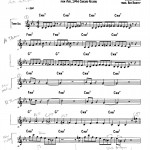
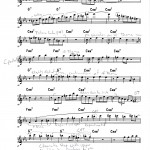
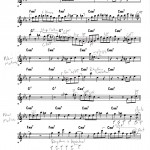
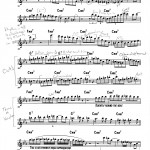
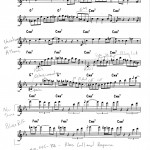
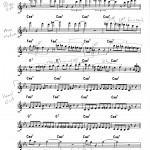
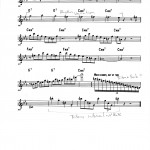
Love it! The transcription looks really clean and accurate – did you consider halving the durations so it’s half the # of measures? Then again, that’d change it from a 12-bar to the less popular 6-bar blues form…so I think you made the right call. lol
Thanks Cory! Yeah, it is a little weird at really fast speeds when half notes feel like what quarter notes usually do; I prefer the transcription to match the form of the tune – makes it easier on my brain when I am studying it!
what about 4/8? 🙂
Just posted an updated version of the PDF to correct a mistake in the transcription (had two notes reversed in mm 25, 27 and 193, 195). Should be B natural then C on the and of 3 and on beat 3.
A very cool idea would be to transcribe the version on Lift and do a side-by-side comparison for the blog. Do it!!
Agreed…It’s on my to do list as a long term project. Such a killer track!